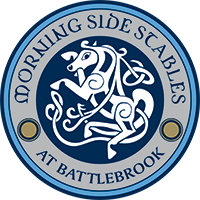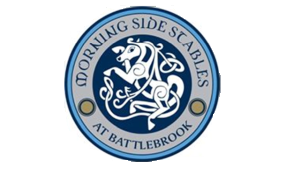Morning Side Riding Curriculum
Our goal at Morning Side Stables is to teach all of our students the love for horses and the skills needed to go wherever that love takes them. Whether you are in need of beginner lessons, intermediate or advanced, we have a program to meet your needs.
Riding Curriculum
- Leading a horse with a bridle and halter
- Ability to mount and dismount on the proper side of the horse
- Walking, halting, and turning/switching directions independently
- Differentiate between the long and short sides of the ring & the upper and lower halves of the ring
- Understand the concept of inside vs. outside
- Understanding that turns must be made to the inside
- Learn how to properly hold the reins
- Ability to lengthen and shorten the reins as needed
- Ability to place feet in stirrups in the proper position and fix that position if necessary
- Mastering the two point position at the halt and walk
- Standing straight up in the saddle at the halt and walk
- Walking with no stirrups
- Balancing with no hands or stirrups on the lunge line
- Ability to maintain heels down and eyes up
- Able to roll up stirrups by themselves after dismounting
- Ability to check the girth before mounting
- Ability to lengthen and shorten reins while maintaining the walk
- Work on picking up and fixing stirrups while maintaining the walk
- Walking over poles both sitting and in two point
- Forming hunter circles at the walk
- Walking over a course of poles both sitting and in two point
- Trotting on the lunge line
- Sitting the trot
- Posting the trot
- Two point at the trot
- Trotting with no hands
- Begin working on the concept of diagonals
- Understand the concept of tracking left or right
- Ability to stay along the railing and go deep into the corners
- Ability to keep distance from other horses and riders
- Understand the concept of switching directions across the diagonal
- Trotting independently off the lunge line
- Knowing what the centerline is and being able to trot down it
- Learn how to use a crop properly when necessary
- Understand the concept of diagonals at the trot
- Switching diagonals at the trot and knowing when it is necessary
- Switching directions at the trot (both circling, through the centerline or middle, and across the diagonal)
- Remembering to check the diagonal & switch it if needed both when the trot is picked up and when changing directions
- Forming a hunter circle at the trot
- Trotting over poles both posting and in two point
- Sitting the trot with no stirrups on the lunge line
- Beginning to post the trot with no stirrups on the lunge line
- Maintaining balance through the walk/trot and trot/walk transitions
- Master posting trot without stirrups off the lunge line
- Understand the concept of an inside and outside bend
- Introduction to cantering on the lunge line
- Cantering on the lunge line with no hands
- W/T/C and C/T/W transitions on the lunge line with no hands the entire time
- Begin cantering off the lunge line up the long side
- Understand what a release is over fences and how to properly perform one
- Learning to jump small verticals at the trot
- Starting to jump small courses comprised of both cross rails and verticals at the trot
- Continue to maintain straightness up to and after a jump throughout a full course
- Introduction to the difference between hunt seat and full seat at the canter
- Continue to develop confidence riding outside of the ring and on trails
- Cantering around the entire ring while going into the corners
- Trotting in, cantering out of a circle
- Full hunter circles at the canter
- Introduction to canter leads
- Cantering over single poles
- Cantering over a line of poles
- Learning how to count strides and find distances over poles and fences
- Beginning to canter over single fences
- Ability to demonstrate the difference between hunt seat and full seat
- Comfortably trotting outside of the ring and on trail rides
- Trotting over poles without stirrups
- Introduction to cantering without stirrups on and off the lunge line
- Ability to independently warm up and cool off the horse
- Ability to adjust stirrup length while mounted
- Full comprehension of leads
- Ability to tell which lead you are on
- Ability to know both when and how to switch it if necessary
- Ability to count how many strides are in between a line of poles or jumps
- Continue to develop an eye for distances
- Learn the difference between a long and short spot and how to ride them
- Continue to jump higher courses at the trot
- Begin jumping full courses of both cross rails and verticals at the canter
- Understand the different paces needed for different types of jumps
- Learning how to extend and collect the gaits
- Confidently cantering off the lunge line without stirrups
- Begin trotting over small cross rails without stirrups
- Ability to stay balanced bareback
- Learn how to walk a line of jumps on foot and count the strides to prepare for showing
- Introduction to oxers at both the trot and canter
- Cantering over poles without stirrups
- Cantering over small jumps without stirrups
- Ability to canter confidently on trails
- Introduction to small jumps on trails and outside of the ring
- Starting to jump lines/combinations with more than 2 jumps incorporated
- Begin working on the walk to canter transition
- Introduction to the different types of releases over fences
- Introduction to grids and gymnastics over fences
- Introduction to basic lateral work (spiraling in and out of a circle, turning on the forehand, leg yields)
Horsemanship Curriculum
- Understanding basic safety rules on the ground and under saddle
- Own the necessary riding equipment (properly fitted helmet, paddock boots, breeches or riding tights) by the A3 level at the latest
- Identify the different grooming tools, know what they are used for and in what order, and be able to fully and properly groom your pony
- Learn how to confidently pick out the hooves
- Understand basic equine body language and how to properly respond (eg: pinned ears, hind end turned away, whites of eyes showing, where a horse’s blind spots are, etc.)
- Know the difference between a horse and a pony
- Know the difference between a mare, gelding, and stallion
- Learn how to put a halter on, catch a pony, and lead them in
- Learn how to cross tie a pony
- Learn the different types of tack, their names, and the proper order to tack a pony up
- Begin tacking up a pony with supervision
- Know how to properly put tack away after use
- Groom, tack up, & untack without supervision (instructor will check tack before lesson)
- Learn the differences between different types of bits, bridles, saddles, and saddle pads
- Introduction the effect of these differences on a horse
- Identify and keep track of the tack needed for the individual horses
- Work on learning the names of the different bridle & saddle pieces
- Work on learning the names and uses of the different types of bits
- Clean tack with supervision
- Know how to blanket a horse in the winter
- Know how to hose or sponge down a horse in the summer
- Be able to keep a greedy horse away from grass
- Know how to effectively muck a stall
- Learn how to check a pony over for basic abnormalities (eg: cuts, scrapes, bumps, swelling, runny eyes/nose, unwillingness to move or put pressure on a specific leg)
- Begin learning basic anatomy and conformation terms
- Tack up horse without needing an instructor to double check
- Ability to identify and label the different parts of the bridle and saddle as well as the names of different bit types
- Understand what different bits, bridles, and saddles are used for and why certain options are used for certain horses
- Ability to disassemble a bridle and put it back together
- Clean tack properly (without leaving soap/conditioner residue) without supervision
- Know how to adjust tack as needed to best fit a horse
- Learn how to tie a quick release knot
- Learn how to lunge a horse with supervision
- Continue learning more advanced anatomy and conformation terminology
- Begin learning how to detect signs of lameness, colic, and other ailments
- Learn how to care for simple wounds
- Fully bathe a horse (making sure to rinse off all soap residue) without supervision
We approach our relationships with our students with one goal in mind – to help them develop the skills they need to take them wherever they want in the equestrian world with a love for horses in their hearts. Tara Ward

